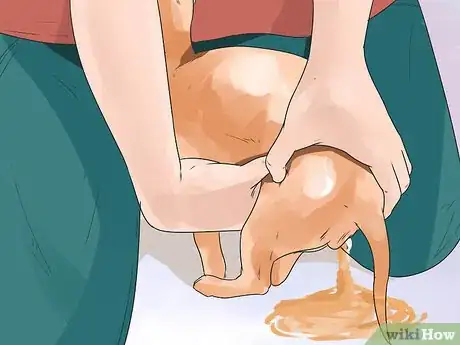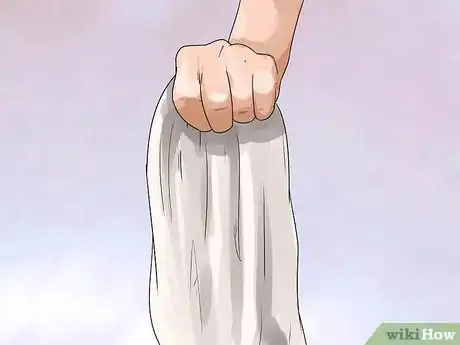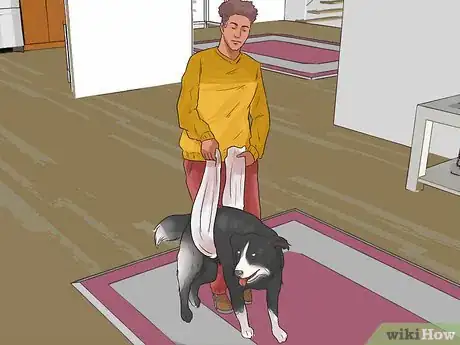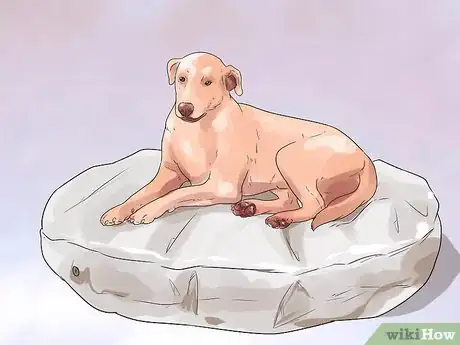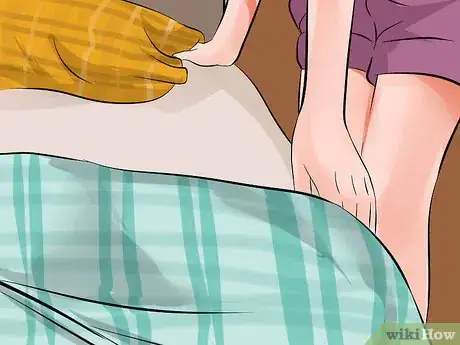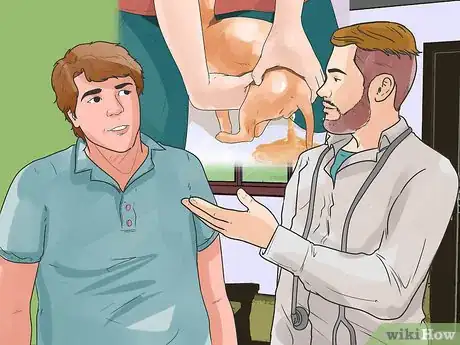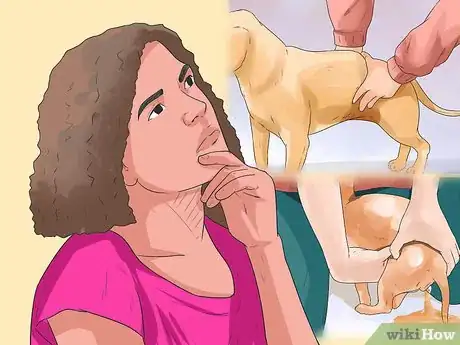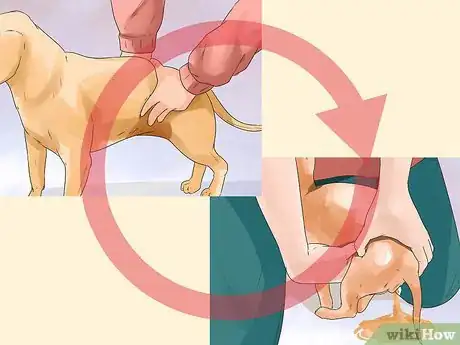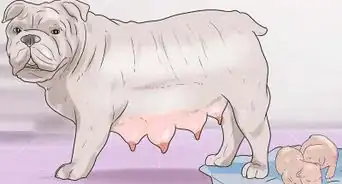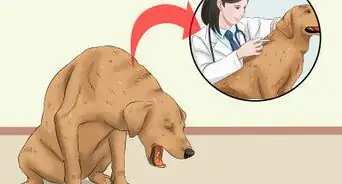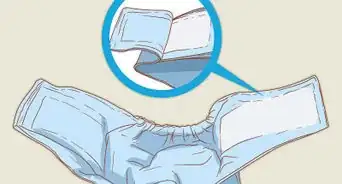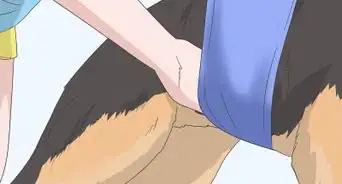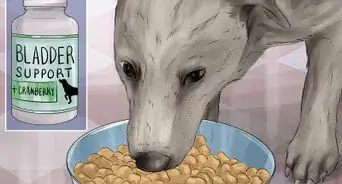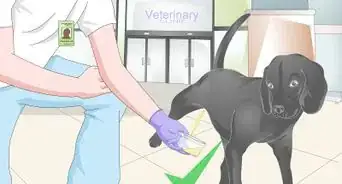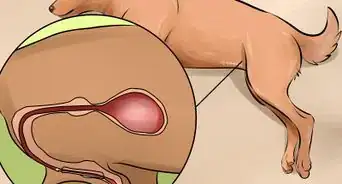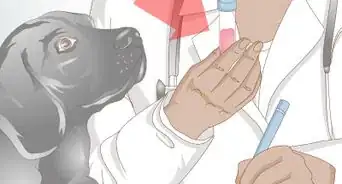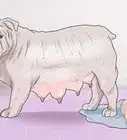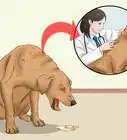This article was co-authored by Jennifer Damon. Jennifer Damon is a Professional Dog Trainer and the Owner of Love for Paws Dog Training in Richmond, VA. With over 10 years of experience training dogs, Jennifer specializes in determining the psychology that motivates dog behavior. As a supporting member of the International Association of Animal Behavior Consultants, Jennifer is passionate about improving the communication between owners and their pets through gentle, scientifically-backed methods. She holds a BFA in Communication Arts from the University of Montevallo and a Certificate in Canine Behavior Consulting from The International College of Canine Studies.
wikiHow marks an article as reader-approved once it receives enough positive feedback. In this case, 92% of readers who voted found the article helpful, earning it our reader-approved status.
This article has been viewed 61,383 times.
Most female dogs squat down in order to urinate. However, animals that have injured their back, pelvis, or hind leg can find it especially difficult to do this. Likewise, some injuries can interfere with the nerve supply to the bladder, which means the dog is unable to urinate on its own no matter what position it is in. Both situations require careful nursing and assistance from the owner, in order to keep the dog comfortable and healthy.
Steps
Supporting a Female Dog in a Squat Position
-
1Commit to helping your dog go to the bathroom. Helping her go to the bathroom will take some commitment on your part. However, just remember that squatting places a strain on bones and muscles, and if one of those bones or muscles is not able to support the dog's weight she is liable to collapse. This will discourage her from trying to urinate again, and she may lie in her bed and soil herself.
-
2Select a towel that can be used as a sling for your dog. A hand towel is fine for a small dog, a bath towel for a medium dog, and a bath sheet for a large dog. Alternatively, improvise with anything that is long and narrow, but if using a belt or similar, just be careful it doesn't dig into her skin or chaff in any way.[1]
- A simple sling can be made from a cotton shopper bag. Slit the side seams so that the bag lies out completely flat. The body of the bag forms the sling which you locate under the belly, then bring the handles together, one on either side, to hold them above her back to form a hoist.
-
3Place the sling on the dog. Hold one end above her back, pass the other end under her belly and up the other side, and grasp the two ends together above her back. This forms a loop with the dog supported in the 'U' of the loop. Slide the sling back so that it rests as far back towards her hips and knees as is comfortable for her. By holding the ends of the towel you can take the weight off her back legs if she's struggling to walk to a toilet spot.[2]
- Keep your dog in a carpeted room so it has more traction on the floor while you put the sling on.[3]
-
4Support the dog's weight at she urinates. As she squats, allow her to assume the squat position but take some of her weight so that she is supported and doesn't tumble if her legs give way.[4] Simply supporting her in a squatting position so that she doesn't collapse can make a big difference to her.[5]
Helping a Bed-Bound Female Dog Urinate
-
1Place a bed-bound dog on an absorbent bed. If the dog is unable to get up, then she may accidentally soil herself. To keep her as clean and comfortable as possible, make sure she is lying on a well-padded bed. VetBed is ideal, as it wicks moisture away from the dog, so if she has an accident the urine is absorbed away from her body.[6]
- Another alternative is to lie her on puppy training pads, as these absorb the urine and there is less of it to irritate her skin.
-
2Change bedding frequently. Try not to leave your dog lying in urine for more than a few minutes. She will also appreciate a blanket bath, where you wash her back end with water to remove urine from her coat and skin. Not only will this keep her smelling sweet but it reduces the chances of infected skin because of urine scald and secondary infections.[7]
-
3Consult with your veterinarian about whether your should be expressing your dog's bladder. This may be necessary either to encourage a bed-bound dog to toilet at a convenient time so that you can clean up after, or if she has nerve damage that makes it difficult for her to pee. Never try to express a dog's bladder until you have been shown how to do this by a vet. This is because squeezing in the wrong place or applying too much pressure could cause serious damage such as rupturing an organ or bursting her bladder.[8]
-
4Learn how to express your dog's bladder. The idea behind the technique is to apply gentle pressure to the bladder so that the resistance from the valve that stops the bladder leaking urine is overcome.[9] The first skill to learn is locating the bladder. This is located at the back of her belly lying along the body wall. In small dogs feel for it with one hand, forming a 'C' shape with your thumb and fingers and placing them either side of the belly. With large dogs it takes two hands, one of either side of the body wall. Press gently inwards until you feel something that feels like a grapefruit.[10]
- Now squeeze evenly across the bladder, Avoid using your fingertips, as this puts a lot of pressure in localized spots. Instead use the flats of your fingers (small dogs) or your palms (large dogs).
- Apply ever increasing pressure until you see a stream of urine passing from the dog's vulva.[11]
- Never apply more than moderate pressure or the level of pressure as demonstrated by the vet. If you have to exert severe pressure the dog either doesn't need to go, you are in the wrong place, or the dog has a problem which renders her unable to pee. Immediately stop, and contact your vet for advice.[12]
-
5Express your dog's bladder regularly. It is important to express the bladder regularly, typically two to four times a day. Follow your vet's advise about the frequency this should be done.
-
6Manage your dog's pain. A female dog with a back, pelvic or limb injury will be in pain. This pain will discourage her from wanting to move around and may inhibit her from being able to squat to go to the bathroom. No animal should be knowing left in pain, so alongside the mobility issue it is important she has adequate pain relief administered. Your veterinarian should prescribe pain relief. If the level of pain relief is appropriate the female dog will be better able to move around, and either squat to urinate by herself or accept assistance to urinate.
- Non-steroidal anti-inflammatory drugs (NSAIDs) are most commonly used, such as Metacam (meloxicam), Rimadyl (carprofen), Onsior (robenacoxib). There drugs have a high safety margin when given with food, but should never be given on an empty stomach, as they can cause gastric ulceration.[13] Always follow the instructions and dose given by your veterinarian closely. If the dog does not eat, or has sickness or diarrhea, then do not give the medication. NSAIDs are most effective against mild to moderate pain.
- Broken bones are often extremely painful and so the dog may need a stronger painkiller. If the dog is already on a NSAID then another drug in combination often gives sufficient pain relief to help the dog be more mobile. A common addition is tramadol, as this is safe alongside an NSAID and give opioid strength pain relief.[14]
- If the dog is in severe pain then she may be prescribed a fentanyl patch. Fentanyl patches are stuck onto the skin for slow release pain relief. They are most commonly used in veterinary hospitals, rather than in private homes. However, some vets will allow a pet home wearing one, under close supervision from clients they know and trust. Vigilance is crucial when using fentanyl patches, as the dog could potentially overdose if they chew and swallow a patch.
Warnings
- Fentanyl is an opioid and is a Schedule II controlled drug in the US. This means a written record must be kept by the vet to account for the use of each patch, they must be ordered in a special way, and the unused patches are stored in a locked drug cupboard. In addition used patches must be disposed of in a government approved manner.⧼thumbs_response⧽
References
- ↑ http://pondicherrycottage.blogspot.co.uk/2014/05/how-to-make-your-own-dog-lift-sling-diy.html
- ↑ Jennifer Damon. Professional Dog Trainer. Expert Interview. 18 August 2021.
- ↑ Jennifer Damon. Professional Dog Trainer. Expert Interview. 18 August 2021.
- ↑ Jennifer Damon. Professional Dog Trainer. Expert Interview. 18 August 2021.
- ↑ http://pondicherrycottage.blogspot.co.uk/2014/05/how-to-make-your-own-dog-lift-sling-diy.html
- ↑ http://www.petplace.com/article/dogs/first-aid-for-dogs/nursing-care-for-sick-dogs/nursing-care-for-your-dog
- ↑ http://www.petplace.com/article/dogs/first-aid-for-dogs/nursing-care-for-sick-dogs/nursing-care-for-your-dog
- ↑ http://www.handicappedpets.com/how-to-express-your-dogs-bladder
- ↑ Jennifer Damon. Professional Dog Trainer. Expert Interview. 18 August 2021.
- ↑ http://www.handicappedpets.com/how-to-express-your-dogs-bladder
- ↑ http://www.handicappedpets.com/how-to-express-your-dogs-bladder
- ↑ http://www.handicappedpets.com/how-to-express-your-dogs-bladder
- ↑ Plumbs veterinary drug handbook. Donald Plumb. Publisher: Wiley-Blackwell
- ↑ Plumbs veterinary drug handbook. Donald Plumb. Publisher: Wiley-Blackwell
